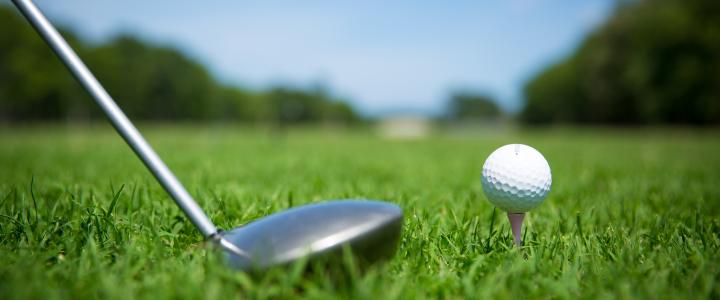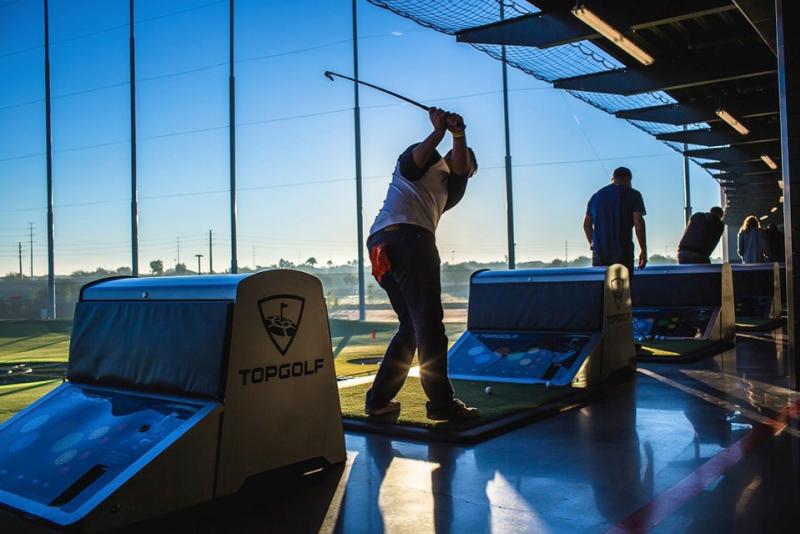
Home to the world’s longest pleasure beach, stunning coastal scenery and picturesque landscapes, Virginia Beach attracts visitors who enjoy outdoor activities. Lucky for golf enthusiasts, this includes an abundance of opportunities to tee off on some great courses.
Public & Semi-Private Golf Courses
Golfers will find notable layouts with easy access and reasonable greens fees throughout Virginia Beach. More than a dozen public courses in the area have been crafted by top golf designers such as Tom Clark, George Cobb, Fred Couples, Pete Dye, Robert Trent Jones, Rees Jones, Ellis Maples and Curtis Strange. From Pungo to Sandbridge to the Inland district, enjoyable public, semi-private and military golf courses await you.
Cypress Point Country Club
Located in a quiet community next to Lake Lawson and Lake Smith, Cypress Point Country Club is a semi-private course that was designed by Thomas Clark of Ault, Clark & Associates and opened in 1987. Measuring 6,541 yards from the back tees, the well-maintained (and well bunkered) par 72 layout carries a rating/slope of 70.6/121. Water comes into play on several holes, including 16 (a par 4 lakeside dogleg) and 17 (a short par 3 over water that is visually intimidating). However, the toughest hole is dry. Hole 7, a 437-yard par 4, doglegs right to an elevated green.
First Tee - Hampton Roads
First Tee - Hampton Roads is a nine-hole walking course located next to Virginia Beach National Golf Course that deserves mention for several reasons, not the least being its desirability for fun rounds with family members. Like Virginia Beach National, it was designed by the iconic and diabolically inventive Pete Dye and his equally talented wife, Alice, so it promises to be memorable. It’s also a VSGA (Virginia State Golf Association) member course, which means players can file their course scores for their official handicaps. The layout measures 1,678 yards from the back tees, and 1,185 yards from the front. The men’s rating/slope is 28.2/85, the women’s 29.3/86. This YMCA-affiliated location offers golf summer camps and junior golf problems.
Hell’s Point Golf Club
When the Rees Jones-designed Hell’s Point Golf Club debuted in 1982, Golf Digest labeled it one of the country’s best new courses in the U.S. and the American Society of Golf Course Architects praised its design. The architect took advantage of the site’s location near the Back Bay National Wildlife Refuge, edging fairways with saltwater wetlands and incorporating many other natural elements. The 6,766-yard par 72 (rating/slope: 72.6/133) is home to more than 60 of Jones’ sculpted bunkers, especially around the fast, bentgrass greens. The second hole, a 462-yard par 4 with OB on the left, trees along the right and a two-tiered green, has a reputation as one of the Tidewater area’s most difficult holes. That said, Hole 17 is one of the golf pro’s favorites. A picturesque 341-yard par 4 doglegging right around water, it tempts players to go for the green, a daunting water carry.
Heron Ridge Golf Club
An impressive Fred Couples/Gene Bates design, Heron Ridge Golf Club opened in 1999. The 7,017-yard par 72 (rating/slope: 74.0/138) has lakes and natural wetlands that come into play on 14 of its 18 holes. Earthmoving to create lakes and raise fairways caused the layout to have more undulations than are normally found in coastal courses, which makes it unusual for the area. Hole 9 is ranked the most difficult. A 554-yard generously bunkered par 5, it doglegs left around water with trees and a creek bordering the right side of the fairway.
Honey Bee Golf Club
The Ress Jones design of the Honey Bee Golf Club has been a popular venue in the area since its debut in 1988. Measuring 5,996 yards from the tips, with a rating/slope of 69.1/126, the par 70 layout is home to tree-lined fairways with numerous lakes and ponds, so that water comes into play on a dozen holes. A round here culminates with a quartet of holes (15 through 18) known as “The Beehive.” It’s a gantlet of tricky, well-bunkered doglegs and a par 3 that is almost 200 yards long. Hole 15, a 446-yard par 5, is the number one handicap. It’s followed by the par 3. Hole 17 is a 399-yard par 4, leading to the final hole, a 498-yard par 5.
Kempsville Greens Golf Course
The venerable Ellis Maples layout of the Kempsville Greens Golf Course debuted in 1957 and underwent a redesign by Russell Breeden in 1984. In 2023, the greens were converted to Champions Bermuda grass. It’s 5,843 yards from the back tees of the par 70, which carries a rating/slope of 68.3/122. Water is present – though not always in play – on a dozen holes, which makes for an attractive layout. The hardest hole, No. 8, lacks water hazards, but is a 441-yard par 4 from the back tees, with bunkers on both sides of the landing area and flanking the green.
Red Wing Lake Golf Course
The George Cobb-created Red Wing Lake Golf Course opened in 1968 and was renovated in 2005 by the Kevin Tucker Design Group. The refresher incorporated new wetland areas and lakes, so that water is in view – and often in play – on about half of the holes. The par 72 layout was stretched to 7,124 yards from the tips for a more modern challenge, with a respectable 73.3/131 rating/slope. Mature loblolly pines line the Bermuda fairways, which lead to quick bentgrass greens. One of the memorable holes is No. 13, a 205-yard par 3 with Red Wing Lake sparkling in the sun on the right.
Stumpy Lake Golf Course
Located in a 1,400-acre nature preserve with a 278-acre lake, Stumpy Lake Golf Course is devoid of houses, which makes for a peaceful setting frequented by deer, foxes, eagles, ospreys and (very rarely) bears. The classic Robert Trent Jones-designed course (6,741-yard par 72, 71.3/127) opened in 1953. Well-tended Bermuda grass fairways and bentgrass greens occupy a peninsula jutting into a cypress bog. Three holes are especially memorable: Hole 5, the number one handicap, is a 423-yard dogleg par 4 with a tempting shortcut through a tree-lined chute. Hole 10, a 394-yard par 4, has a sloped green that sends approach shots back to the fairway. No. 18, a 398-yard par 4, is an unofficial signature hole with a pretty pond fronting the green. The clubhouse overlooks the green and Stumpy Lake, so there’s always an audience for your approach shot over water.
Virginia Beach National Golf Club
A collaboration between Pete Dye and Curtis Strange, the Virginia Beach National Golf Club opened in 1999 as a TPC venue and remains PGA Tour quality in design and maintenance. The par 72 layout measures 7,003 yards (73.8/130) from the back tees. Out-of-bounds areas are planted with tall ornamental grasses that undulate in the wind off the ocean, which is unseen but nearby and always a factor. In typical Dye fashion, holes that look intimidating from the tee often turn out to be forgiving – but it’s still easy to get into trouble. The course comes to a memorable finish with a 452-yard par 4 sweeping left alongside a lake, reminiscent of another great finishing hole by Dye and his wife Alice – TPC Sawgrass.
Military Golf Courses
If you’re in the military or have a playing buddy who is and will take you as a guest, you can play notable Virginia Beach courses that are not open to the general public. A military ID is required to access the Joint Expeditionary Base Little Creek-Fort Story, where the Eagle Haven Golf Course (par 71, 6,265 yards, 70.9/131) is located, and the Oceana Naval Air Station, home to the Aeropines Golf Club. Aeropines features two 18-hole, par 72 Jerry Pate-designed courses: the Hornet (6,959 yards) and the Tomcat (6,798 yards).

Golf-Themed Attractions
If you feel like taking a swing beyond the day’s round, several attractions await where you can bring friends and family and continue your love of golf, day or night.
Topgolf Virginia Beach
The Topgolf Virginia Beach entertainment complex is a good place to sharpen your club skills, introduce new players to the basics, or simply escape the occasional rainy day without sacrificing swing time. Not only are there no pace-of-play pressures like on the golf course, but you can also enjoy a meal or cocktails in a comfortable setting. From your covered bay, you’ll hit micro-chipped balls that will give you feedback on distance and direction – a perfect warm-up for your next round. Topgolf is family-friendly, so no need to find a babysitter if you’re traveling with the kids.
Miniature Golf Courses
Enjoy some family fun while improving your putting skills in one of many clever mini-golf courses at the Oceanfront. At Jungle Golf, putt your way through topsy-turvy challenges guarded by large African beasts and water hazards. At Pirates Paradise, golf holes wind among waterways under the gaze of sinister sailors who once prowled the high seas in search of treasure. For a unique putting experience, King Neptune’s Mini Golf is an indoor blacklight facility with 10 funky 3-D golf holes.
About Our Writer
Based in the Eastern Panhandle of West Virginia, Dale Leatherman is a past president of the Society of American Travel Writers. She specializes in golf and adventure travel as well as equestrian sports. Her outlets include AAA publications, Global Traveler and Equine Network magazines such as EQUUS.






